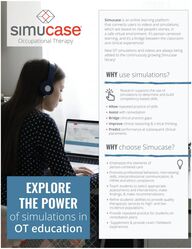
Return to flip book view
Simucase is an online learning platform that connects users to videos and simulations which are based on real people s stories in a safe virtual environment It s person centered learning and it s a bridge between the classroom and clinical experiences Occupational Therapy New OT simulations and videos are always being added to the continuously growing Simucase library WHY use simulations Research supports the use of simulations to determine and build competency based skills Allow repeated practice of skills Assist with remediation Bridge clinical practice gaps Improve clinical reasoning critical thinking Predict performance at subsequent clinical placements WHY choose Simucase Simucase Supervision Services With Simucase Supervision Services an expert simulation educator from Simucase partners with you to provide a customized virtual clinical experience for your students The supervisor supports your implementation of Simucase by leading pre brief and debrief sessions providing grade recommendations and tracking and approving students clinical hours SCHEDULE A DEMO Please email us at sales simucase com to schedule your free demo Emphasize the elements of person centered care Promote professional behaviors interviewing skills interprofessional communication HIPAA and ethics compliance EXPLORE THE POWER Teach students to select appropriate assessments and interventions make ndings make recommendations Re ne students abilities to provide quality therapeutic services to high and lowincidence populations Provide repeated practice for students on remediation plans Supplement provide Level I Fieldwork experiences 855 747 9547 This product or portions thereof was manufactured under license from Case Western Reserve University U S Patent Numbers 9 911 352 10 089 895 Canadian Patent Number 2 673 644 U K Patent Number 2458054 Australian Patent Number 2007342471 of simulations in OT education
Case History Complete a client interview Select relevant questions review referrals and reports and gather information Collaborators Access medical records and if relevant collaborate with members of the interdisciplinary team HOW simulations work Assessments Select and administer tests and measures gather data to con rm or reject hypotheses The clinical pathway Findings Select previously gathered medical diagnoses Identify primary occupational therapy ndings and functional de cits Recommendations Synthesize gathered information Identify appropriate prognosis referrals and interventions